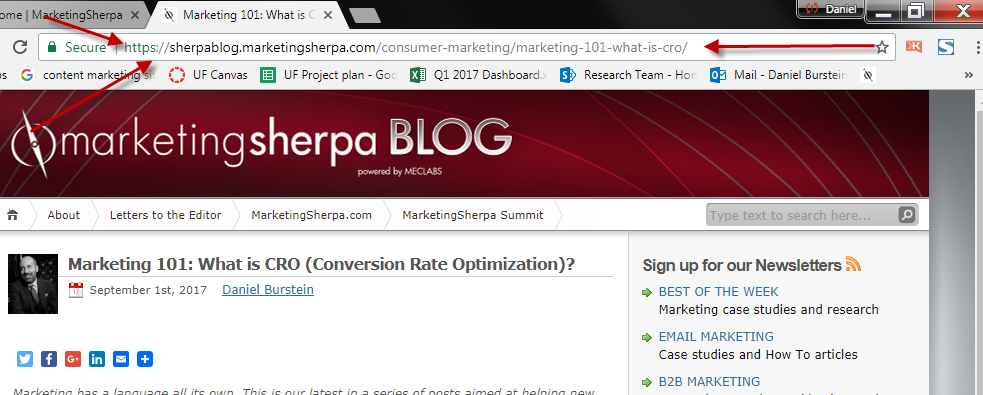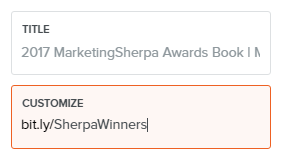Marketing 101: What is a vanity link (or vanity URL)?
Marketing has a language all its own. This is our latest in a series of posts aimed at helping new marketers learn that language. What term do you find yourself explaining most often to new hires during onboarding? Let us know.
A vanity link is a URL that is in plain English and very easy for a potential web visitor to type in. URL is an acronym for Uniform Resource Locator — the webpage address. Every page on the World Wide Web has a URL, even this one. To find the URL of any webpage, simply look in the browser bar at the top.
Vanity links make it easier for people to visit your landing pages
If you’re sending people to a landing page, blog post or online article from a webpage, it’s easy enough to use a hyperlink — like this — to allow your visitors to click and visit the other page.
However, there are times when you would like to create a call-to-action to a webpage that readers or listeners will actually have to type into a web browser themselves. An example might be a TV or radio ad. Or a print advertisement. For this reason, a vanity link isn’t technically a “link” at all, but rather a URL (i.e., the web address).
For example, the URL for our customer satisfaction study is fairly easy compared to some URLs: http://www.marketingsherpa.com/freestuff/customer-first-study
However, why put that on the customer? It’s in the “Free Stuff” section of MarketingSherpa, so that’s why those words are in the URL. But why make the customer type that in? Or even the hyphens between “customer” and “first” and “study.” The HTTP and www aren’t necessary either.
When we wanted to direct someone to that website and couldn’t use a link, we created this simple vanity URL: MarketingSherpa.com/ConsumerStudy
Notice how much easier that is to type in and remember. Also notice the camel casing — I made the first letter of each word a capital letter so the URL is easier to read and remember, although visitors could type the URL with all lowercase letters and still get to the webpage.
Vanity URLs to send visitors to other websites
The URL we created a vanity for was already somewhat simple. It was just a few words after the domain name MarketingSherpa, really.
However, some names are very complex. A video I was in was featured in a local print newspaper a few years ago. And I had to laugh when I saw the URL they provided to their readers.
You’d have to be pretty, pretty, pretty motivated to type in that long string of words, letters and numbers into your browser.
Now, a vanity URL is really just a pointer to another URL, also known as a redirect. People type in the vanity URL you created and then are redirected to where you want them to go. And for that reason, you can create vanity URLs that send visitors to other websites.
To show you an example, here’s a vanity URL I created that will take you to a YouTube video: MarketingSherpa.com/MoreThanEmail
Vanity URLs can also help with tracking
One challenge of offline advertising is tracking. With an email or a digital ad, it’s very easy to see where the visitor came from when they click through on the banner ad and end up on your site. Not so for offline advertising. However, vanity URLs can help here as well.
With your analytics platform, you can add different parameters to the URL to help track where visitors come from, what they do and where they go. Here’s an example:
This works because anything after the “?” in the URL is ignored by the browser when it sends you on your merry old way to your webpage destination. Here, try it out for yourself. Type “MarketingSherpa.com?YourFavoriteSpiceGirl” into your browser. It doesn’t matter if you put in Ginger Spice or Baby Spice after the question mark, you will still get to our homepage.
If you look at the tracking URL above, the different parameters in it can help you track at a more macro level by different factors. You can copy and paste that URL and put your own factors in. Or, if you use Google Analytics, go to this handy Campaign URL builder form, fill out the different fields, and the URL will be generated for you.
So, back to the above URL. That URL is very helpful for tracking, but no one wants to type in https://meclabs.com/about/heuristic?utm_source=MEx-general&utm_medium=email&utm_content=conversionheuristic&utm_campaign=bairfind from a source they can’t click on.
But I can create a vanity URL: MarketingSherpa.com/CompellingKeyword … et voila! It’s easy for a potential customer to type the URL in, and all of the tracking information is included when they visit a webpage. You can try it for yourself. Just type MarketingSherpa.com/CompellingKeyword into your browser, and you’ll see all of the tracking info in the browser’s address bar.
How to make a vanity URL
Now, you may be thinking. “Daniel, you must be some sort of computer mastermind to be able to make these URLs, engaged in all-night hackathons with Matthew Broderick’s character in ‘WarGames.’”
I’m afraid that’s not so at all. I can barely figure out how to turn on a computer.
This is really simple stuff. A lot of content management systems (CMS) have a plugin or control panel where you can easily make a vanity URL.
For example, in MarketingSherpa’s homegrown CMS, it’s as easy as putting in the vanity URL you want, where you want that URL to send people, and clicking “Add.”
Here’s a screen shot to show you:
It took me 10 seconds to make the short and easy MarketingSherpa.com/YoureSoVain point to the long and confusing https://www.marketingsherpa.com/freestuff/the-MECLABS-guide-for-optimizing-your-webpages-and-better-serving-your-customers
If all else fails, go Bitly
However, let’s say you are not on good terms with your developers or your IT department.
In that case, you could simply customize a bitly. Just go to Bitly and paste in a URL. Then customize your bitly. For example, I created bit.ly/SherpaWinners (and all bitlys will also work with a .com, so I could also put it in a print ad as bitly.com/SherpaWinners, which might be clearer to a less tech- or marketing-savvy audience that is less familiar with bitlys).
Creating a custom bitly is better than trying to put a link like this in a print ad, brochure or event program: https://www.marketingsherpa.com/freestuff/2017-MarketingSherpa-awards-book
However, a custom bitly is not nearly as good as creating your vanity URLs on your brand’s domain. It hurts your branding. It could make it seem like your company doesn’t have its act together. Bitlys are case sensitive, so if you type in bit.ly/SherpaWinners, my customized bitly will work, but bit.ly/sherpawinners does not work.
And, unlike a URL on your company’s domain, you can’t create any vanity URL you want. For example, the above custom bitly I originally tried to make was bit.ly/WinnerWinnerChickenDinner. Because I wanted you to laugh. However, that custom bitlink was taken — by a legal conference back in 2013.
You can follow Daniel Burstein, Senior Director, Content, MarketingSherpa, on Twitter @DanielBurstein.
If you’re reading this blog post, you are likely engaged building a landing page. So you might also like …
PURL Jam: 6 ways personalized URLS can help increase the virality of your campaigns
Marketing 101: What is a squeeze page?
Landing Page Optimization Online Certification Course Level 1 (from MarketingSherpa’s parent research organization, MECLABS Institute)
Download the free Guide to Optimizing Your Webpages and Better Serving Your Customers
Categories: Search Marketing custom redirects, landing page, landing page optimization, redirects, vanity link, vanity URL














